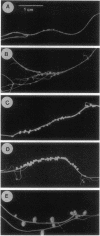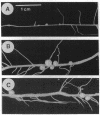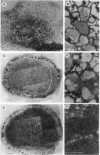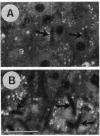Abstract
Purine auxotrophs of various Rhizobium species are symbiotically defective, usually unable to initiate or complete the infection process. Earlier studies demonstrated that, in the Rhizobium etli-bean symbiosis, infection by purine auxotrophs is partially restored by supplementation of the plant medium with 5-amino-imidazole-4-carboxamide (AICA) riboside, the unphosphorylated form of the purine biosynthetic intermediate AICAR. The addition of purine to the root environment does not have this effect. In this study, purine auxotrophs of Rhizobium fredii HH303 and Rhizobium leguminosarum 128C56 (bv. viciae) were examined. Nutritional and genetic characterization indicated that each mutant was blocked in purine biosynthesis prior to the production of AICAR. R. fredii HH303 and R. leguminosarum 128C56 appeared to be deficient in AICA riboside transport and/or conversion into AICAR, and the auxotrophs derived from them grew very poorly with AICA riboside as a purine source. All of the auxotrophs elicited poorly developed, uninfected nodules on their appropriate hosts. On peas, addition of AICA riboside or purine to the root environment led to enhanced nodulation; however, infection threads were observed only in the presence of AICA riboside. On soybeans, only AICA riboside was effective in enhancing nodulation and promoting infection. Although AICA riboside supplementation of the auxotrophs led to infection thread development on both hosts, the numbers of bacteria recovered from the nodules were still 2 or more orders of magnitude lower than in fully developed nodules populated by wild-type bacteria. The ability to AICA riboside to promote infection by purine auxotrophs, despite serving as a very poor purine source for these strains, supports the hypothesis that AICAR plays a role in infection other than merely promoting bacterial growth.
Full text
PDF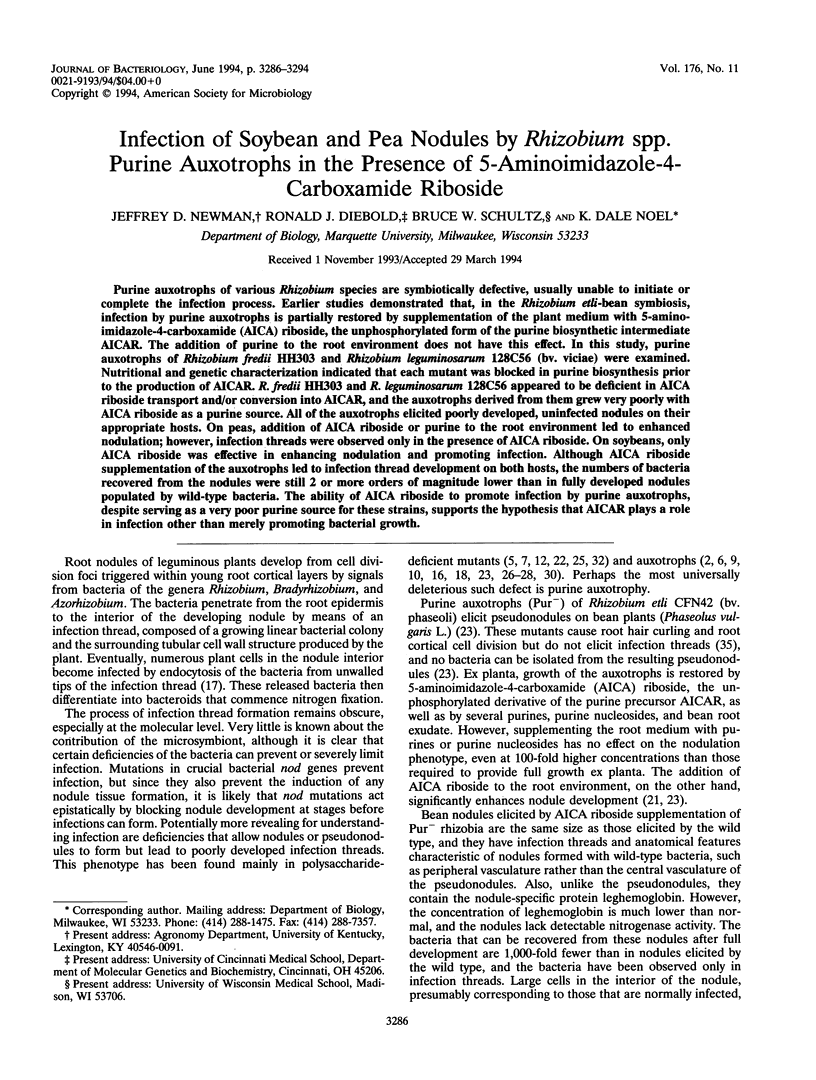
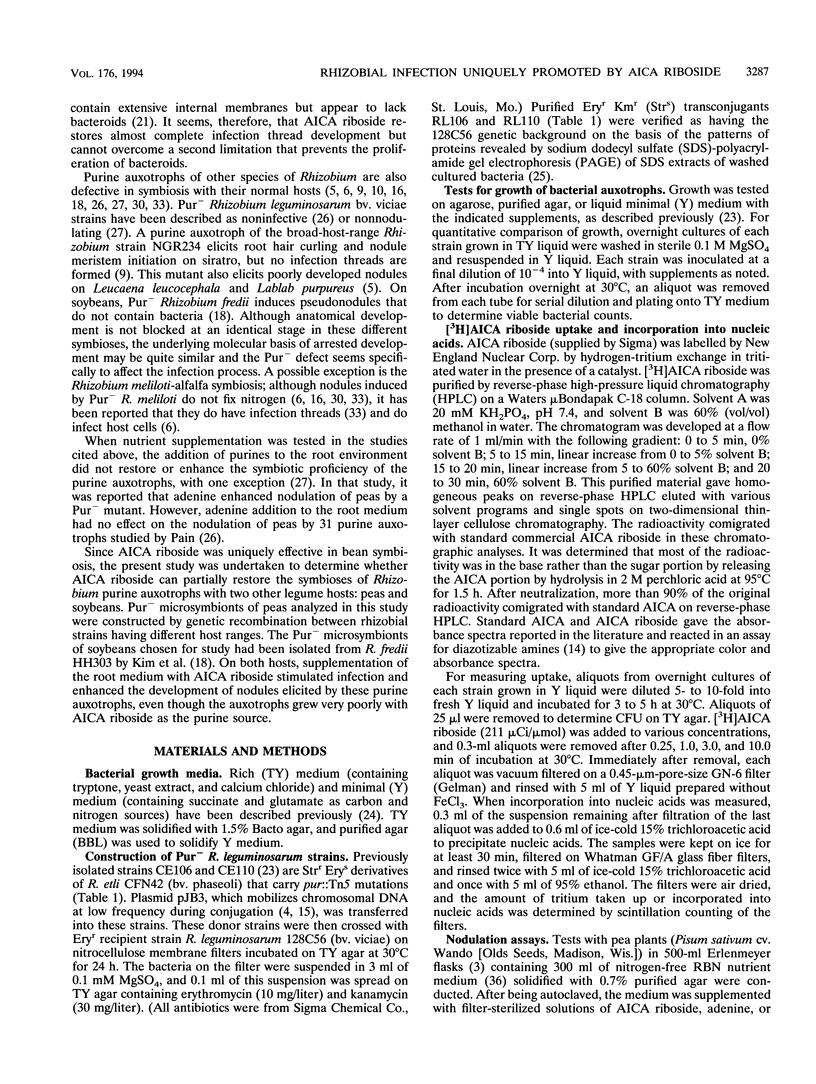
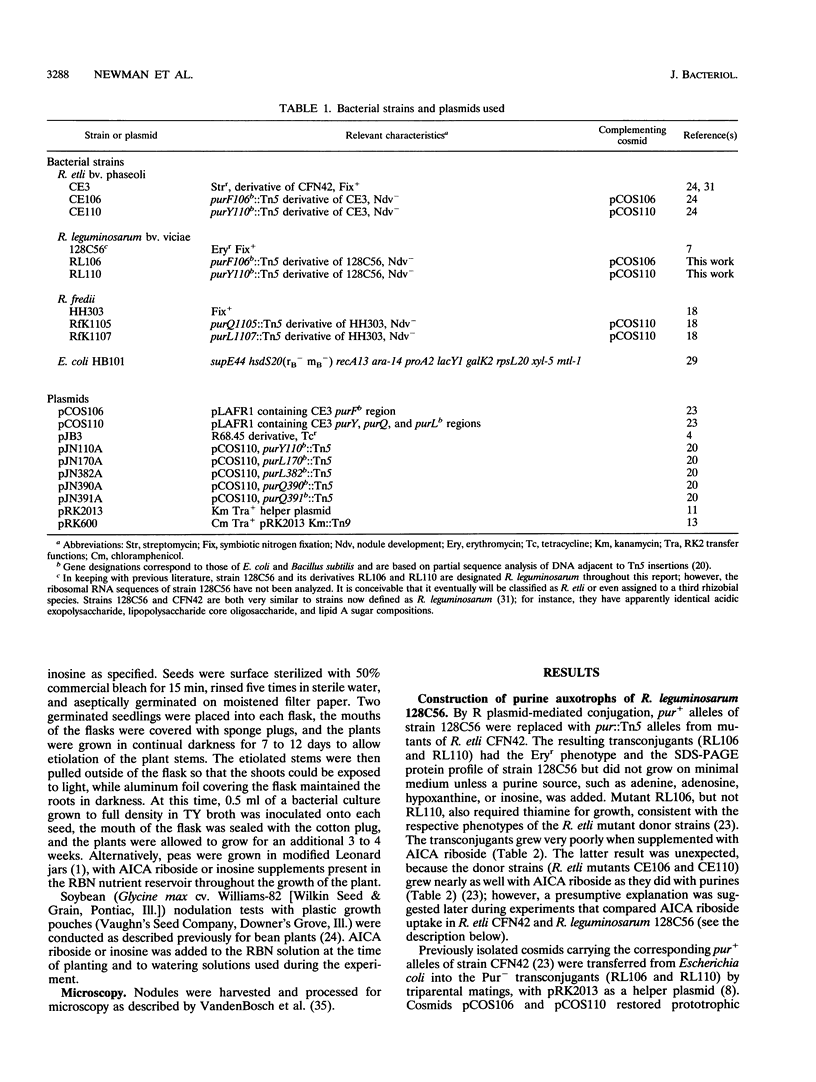
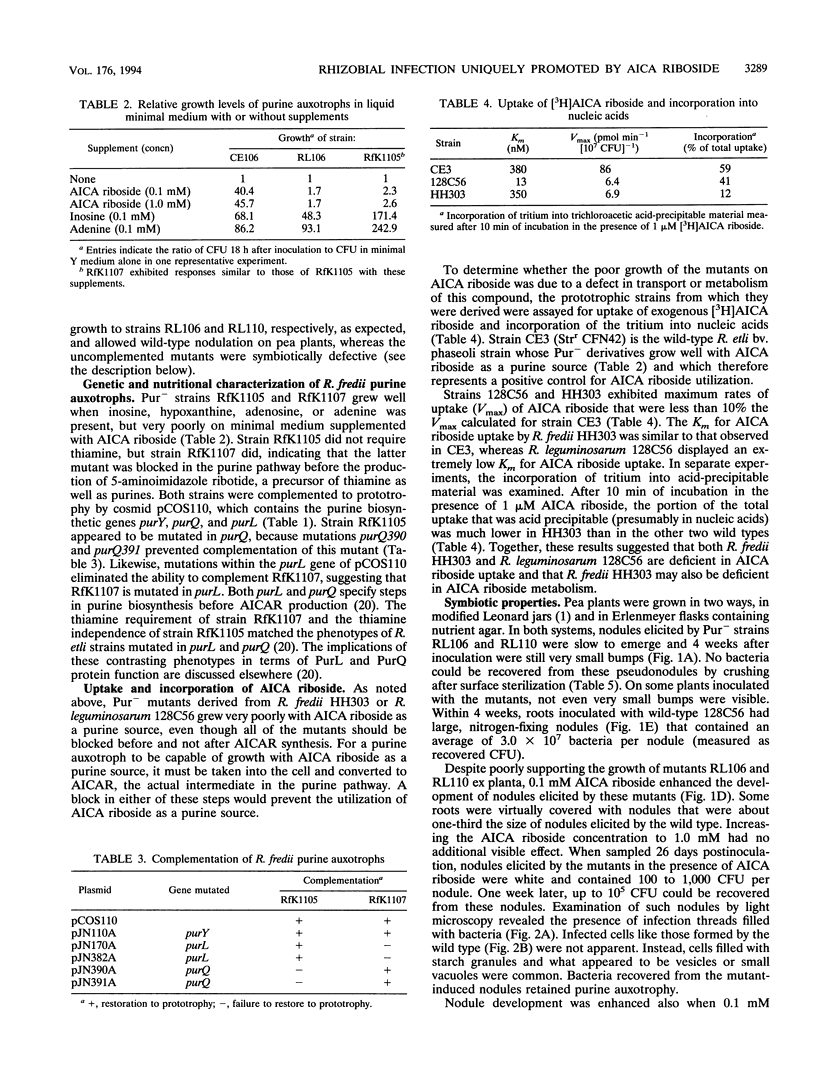
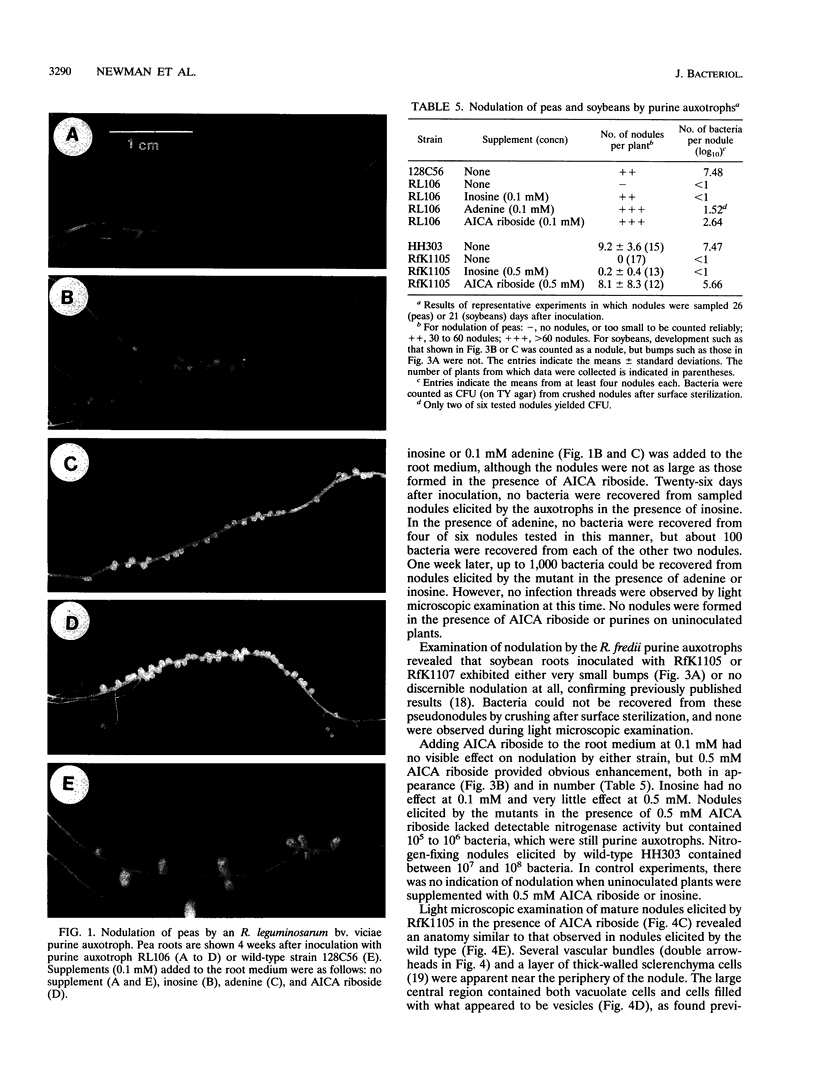
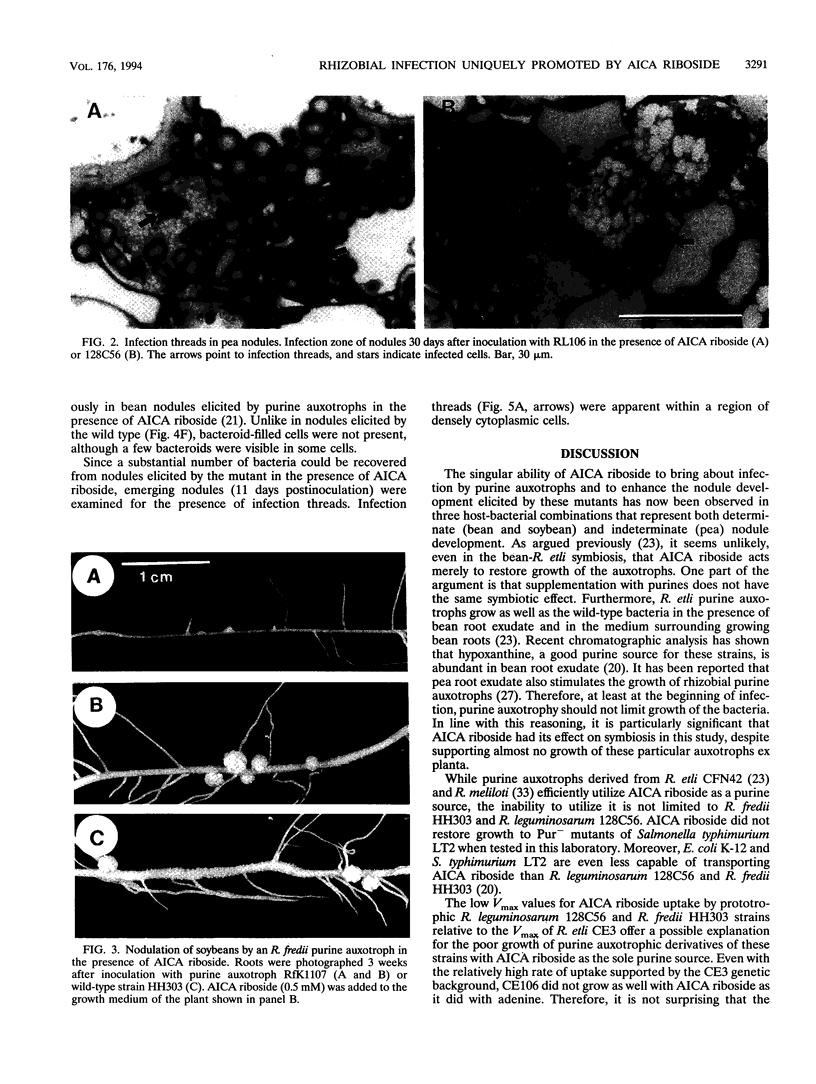
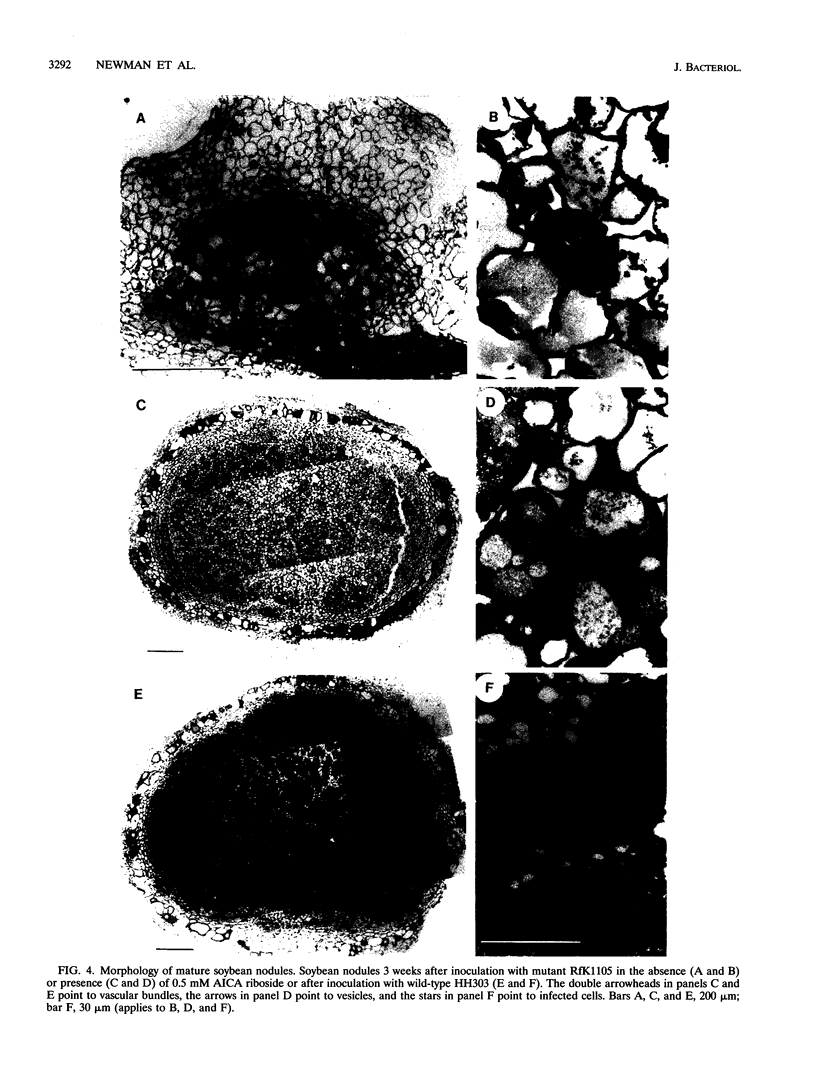
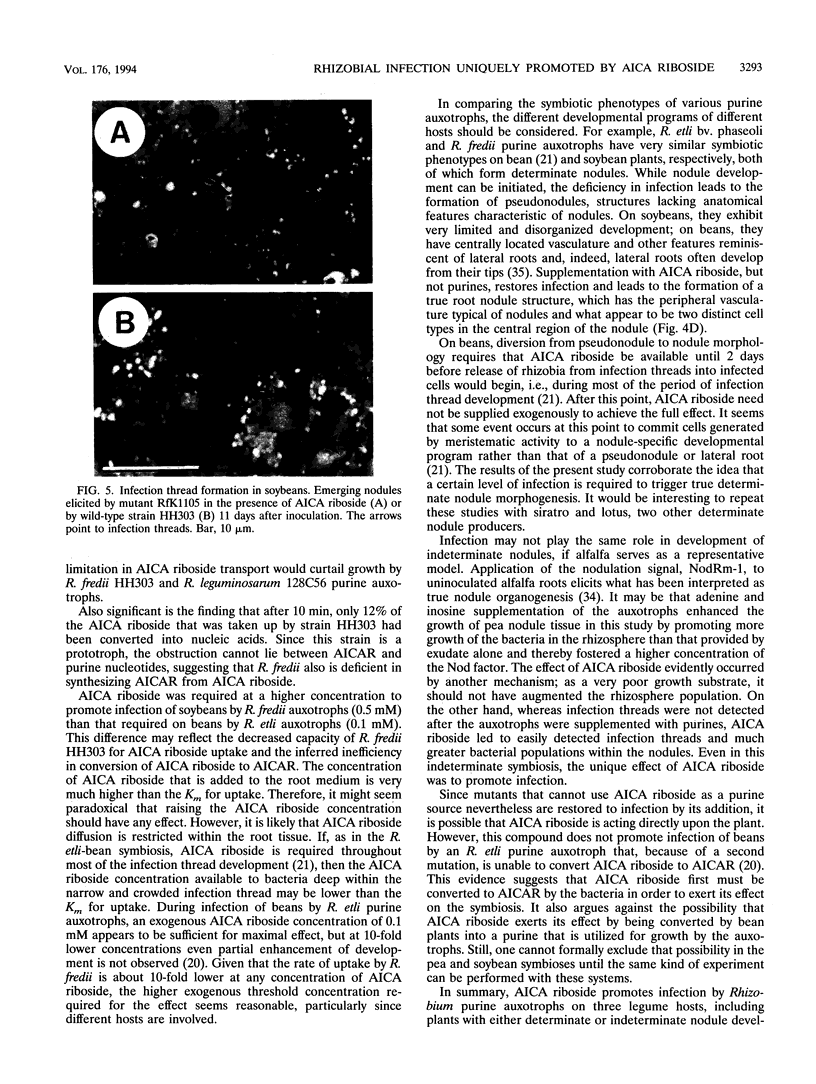
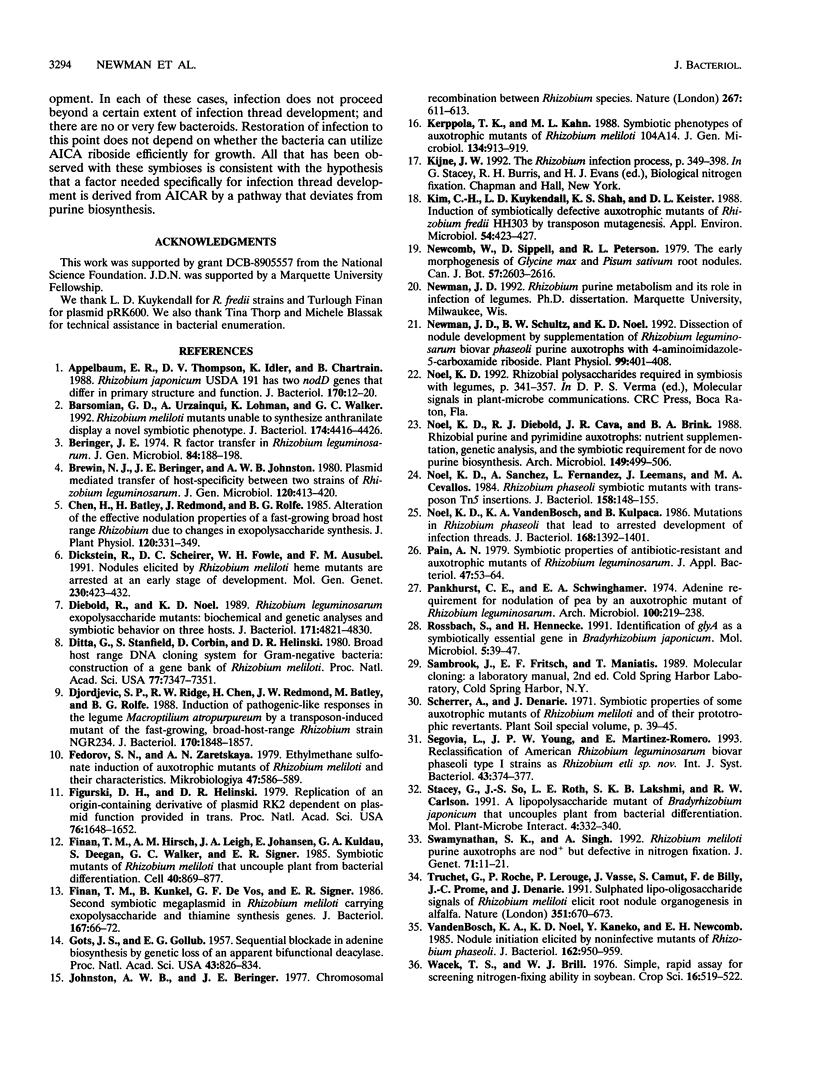
Images in this article
Selected References
These references are in PubMed. This may not be the complete list of references from this article.
- Appelbaum E. R., Thompson D. V., Idler K., Chartrain N. Rhizobium japonicum USDA 191 has two nodD genes that differ in primary structure and function. J Bacteriol. 1988 Jan;170(1):12–20. doi: 10.1128/jb.170.1.12-20.1988. [DOI] [PMC free article] [PubMed] [Google Scholar]
- Barsomian G. D., Urzainqui A., Lohman K., Walker G. C. Rhizobium meliloti mutants unable to synthesize anthranilate display a novel symbiotic phenotype. J Bacteriol. 1992 Jul;174(13):4416–4426. doi: 10.1128/jb.174.13.4416-4426.1992. [DOI] [PMC free article] [PubMed] [Google Scholar]
- Beringer J. E. R factor transfer in Rhizobium leguminosarum. J Gen Microbiol. 1974 Sep;84(1):188–198. doi: 10.1099/00221287-84-1-188. [DOI] [PubMed] [Google Scholar]
- Dickstein R., Scheirer D. C., Fowle W. H., Ausubel F. M. Nodules elicited by Rhizobium meliloti heme mutants are arrested at an early stage of development. Mol Gen Genet. 1991 Dec;230(3):423–432. doi: 10.1007/BF00280299. [DOI] [PubMed] [Google Scholar]
- Diebold R., Noel K. D. Rhizobium leguminosarum exopolysaccharide mutants: biochemical and genetic analyses and symbiotic behavior on three hosts. J Bacteriol. 1989 Sep;171(9):4821–4830. doi: 10.1128/jb.171.9.4821-4830.1989. [DOI] [PMC free article] [PubMed] [Google Scholar]
- Ditta G., Stanfield S., Corbin D., Helinski D. R. Broad host range DNA cloning system for gram-negative bacteria: construction of a gene bank of Rhizobium meliloti. Proc Natl Acad Sci U S A. 1980 Dec;77(12):7347–7351. doi: 10.1073/pnas.77.12.7347. [DOI] [PMC free article] [PubMed] [Google Scholar]
- Djordjevic S. P., Ridge R. W., Chen H. C., Redmond J. W., Batley M., Rolfe B. G. Induction of pathogenic-like responses in the legume Macroptilium atropurpureum by a transposon-induced mutant of the fast-growing, broad-host-range Rhizobium strain NGR234. J Bacteriol. 1988 Apr;170(4):1848–1857. doi: 10.1128/jb.170.4.1848-1857.1988. [DOI] [PMC free article] [PubMed] [Google Scholar]
- Figurski D. H., Helinski D. R. Replication of an origin-containing derivative of plasmid RK2 dependent on a plasmid function provided in trans. Proc Natl Acad Sci U S A. 1979 Apr;76(4):1648–1652. doi: 10.1073/pnas.76.4.1648. [DOI] [PMC free article] [PubMed] [Google Scholar]
- Finan T. M., Hirsch A. M., Leigh J. A., Johansen E., Kuldau G. A., Deegan S., Walker G. C., Signer E. R. Symbiotic mutants of Rhizobium meliloti that uncouple plant from bacterial differentiation. Cell. 1985 Apr;40(4):869–877. doi: 10.1016/0092-8674(85)90346-0. [DOI] [PubMed] [Google Scholar]
- Finan T. M., Kunkel B., De Vos G. F., Signer E. R. Second symbiotic megaplasmid in Rhizobium meliloti carrying exopolysaccharide and thiamine synthesis genes. J Bacteriol. 1986 Jul;167(1):66–72. doi: 10.1128/jb.167.1.66-72.1986. [DOI] [PMC free article] [PubMed] [Google Scholar]
- Gots J. S., Gollub E. G. SEQUENTIAL BLOCKADE IN ADENINE BIOSYNTHESIS BY GENETIC LOSS OF AN APPARENT BIFUNCTIONAL DEACYLASE. Proc Natl Acad Sci U S A. 1957 Sep 15;43(9):826–834. doi: 10.1073/pnas.43.9.826. [DOI] [PMC free article] [PubMed] [Google Scholar]
- Kerppola T. K., Kahn M. L. Symbiotic phenotypes of auxotrophic mutants of Rhizobium meliloti 104A14. J Gen Microbiol. 1988 Apr;134(4):913–919. doi: 10.1099/00221287-134-4-913. [DOI] [PubMed] [Google Scholar]
- Kim C. H., Kuykendall L. D., Shah K. S., Keister D. L. Induction of Symbiotically Defective Auxotrophic Mutants of Rhizobium fredii HH303 by Transposon Mutagenesis. Appl Environ Microbiol. 1988 Feb;54(2):423–427. doi: 10.1128/aem.54.2.423-427.1988. [DOI] [PMC free article] [PubMed] [Google Scholar]
- Newman J. D., Schultz B. W., Noel K. D. Dissection of Nodule Development by Supplementation of Rhizobium leguminosarum biovar phaseoli Purine Auxotrophs with 4-Aminoimidazole-5-Carboxamide Riboside. Plant Physiol. 1992 Jun;99(2):401–408. doi: 10.1104/pp.99.2.401. [DOI] [PMC free article] [PubMed] [Google Scholar]
- Noel K. D., Sanchez A., Fernandez L., Leemans J., Cevallos M. A. Rhizobium phaseoli symbiotic mutants with transposon Tn5 insertions. J Bacteriol. 1984 Apr;158(1):148–155. doi: 10.1128/jb.158.1.148-155.1984. [DOI] [PMC free article] [PubMed] [Google Scholar]
- Noel K. D., Vandenbosch K. A., Kulpaca B. Mutations in Rhizobium phaseoli that lead to arrested development of infection threads. J Bacteriol. 1986 Dec;168(3):1392–1401. doi: 10.1128/jb.168.3.1392-1401.1986. [DOI] [PMC free article] [PubMed] [Google Scholar]
- Rossbach S., Hennecke H. Identification of glyA as a symbiotically essential gene in Bradyrhizobium japonicum. Mol Microbiol. 1991 Jan;5(1):39–47. doi: 10.1111/j.1365-2958.1991.tb01824.x. [DOI] [PubMed] [Google Scholar]
- Segovia L., Young J. P., Martínez-Romero E. Reclassification of American Rhizobium leguminosarum biovar phaseoli type I strains as Rhizobium etli sp. nov. Int J Syst Bacteriol. 1993 Apr;43(2):374–377. doi: 10.1099/00207713-43-2-374. [DOI] [PubMed] [Google Scholar]
- Stacey G., So J. S., Roth L. E., Lakshmi SK B., Carlson R. W. A lipopolysaccharide mutant of Bradyrhizobium japonicum that uncouples plant from bacterial differentiation. Mol Plant Microbe Interact. 1991 Jul-Aug;4(4):332–340. doi: 10.1094/mpmi-4-332. [DOI] [PubMed] [Google Scholar]
- Vandenbosch K. A., Noel K. D., Kaneko Y., Newcomb E. H. Nodule initiation elicited by noninfective mutants of Rhizobium phaseoli. J Bacteriol. 1985 Jun;162(3):950–959. doi: 10.1128/jb.162.3.950-959.1985. [DOI] [PMC free article] [PubMed] [Google Scholar]



